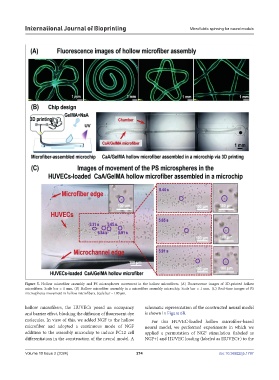Page 282 - IJB-10-2
P. 282
International Journal of Bioprinting Microfluidic spinning for neural models
Figure 5. Hollow microfiber assembly and PS microspheres movement in the hollow microfibers. (A) Fluorescence images of 3D-printed hollow
microfibers. Scale bar = 1 mm. (B) Hollow microfiber assembly in a microfiber assembly microchip. Scale bar = 1 mm. (C) Real-time images of PS
microspheres movement in hollow microfibers. Scale bar = 100 µm.
hollow microfibers, the HUVECs posed an occupancy schematic representation of the constructed neural model
and barrier effect, blocking the diffusion of fluorescent dye is shown in Figure 6B.
molecules. In view of this, we added NGF to the hollow For this HUVEC-loaded hollow microfiber-based
microfiber and adopted a continuous mode of NGF neural model, we performed experiments in which we
addition to the assembly microchip to induce PC12 cell applied a permutation of NGF stimulation (labeled as
differentiation in the construction of the neural model. A NGF+) and HUVEC loading (labeled as HUVEC+) to the
Volume 10 Issue 2 (2024) 274 doi: 10.36922/ijb.1797

